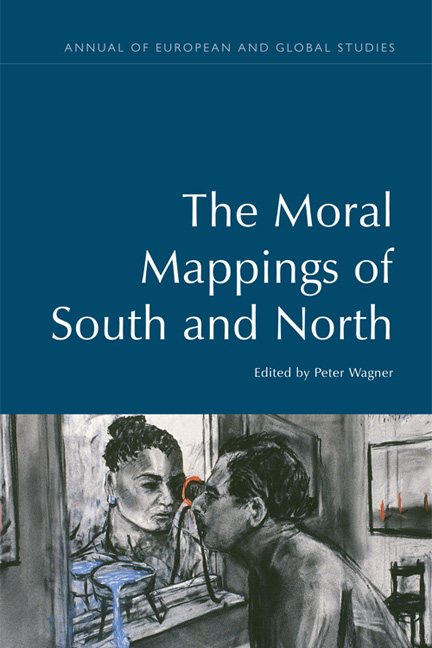Book contents
- Frontmatter
- Contents
- List of Figures
- Notes on the Contributors
- Acknowledgements
- 1 Finding One's Way in Global Social Space
- 2 Does the World Have a Spatio-political Form? Preliminaries
- 3 The BRICS Countries: Time and Space in Moral Narratives of Development
- 4 Russia between East, West and North: Comments on the History of Moral Mapping
- 5 Digging for Class: Thoughts on the Writing of a Global History of Social Distinction
- 6 North–South and the Question of Recognition: A Constellation Saturated with Tensions
- 7 On Spaces and Experiences: Modern Displacements, Interpretations and Universal Claims
- 8 The South as Exile
- Index
3 - The BRICS Countries: Time and Space in Moral Narratives of Development
- Frontmatter
- Contents
- List of Figures
- Notes on the Contributors
- Acknowledgements
- 1 Finding One's Way in Global Social Space
- 2 Does the World Have a Spatio-political Form? Preliminaries
- 3 The BRICS Countries: Time and Space in Moral Narratives of Development
- 4 Russia between East, West and North: Comments on the History of Moral Mapping
- 5 Digging for Class: Thoughts on the Writing of a Global History of Social Distinction
- 6 North–South and the Question of Recognition: A Constellation Saturated with Tensions
- 7 On Spaces and Experiences: Modern Displacements, Interpretations and Universal Claims
- 8 The South as Exile
- Index
Summary
Modernity has not only been merely preoccupied with progress and advance, but also loss and disappearance. Loss is also good to think in regard to what it means to be Modern.
Sumathi Ramaswamy, The Lost Land of LemuriaIN NOVEMBER 2001, an economist at a London investment bank was going over lists of international GDP indicators, comparing the developed countries of the G7 with what he called ‘some of the largest emerging market economies’. He concluded that Brazil, Russia, China and India would be the world's leading economies by 2050, surpassing the six most prosperous countries of the West. Although the statement was bold, it came within a brief seven-page working paper brightly titled ‘Building Better Global Economic BRICs’ (O'Neill 2001). The very suggestion of a ‘better world’ right around Christmas time was a welcome relief after a fiscal year marked by the impact of the September 11 attacks.
Time has passed and Jim O'Neill's argument has gained resonance. Since 2001, his futurological forecast has attracted its share of fans. International media brought together market economists and government technocrats for live debates, skyrocketing online sales of self-help literature on global developmentalism. At the heart of the argument, an old question persisted: can peripheral countries play leading roles on the world's political and economic agenda for promoting development and progress?
In further articles and interviews O'Neill, senior analyst at Goldman Sachs Bank, insisted that the BRICs would be the new global locomotive, moving down the target date of the forthcoming future, from 2050 to 2039 and then to 2032 – sustained by the projection of the huge annual growth rates of those countries between 2001 and 2012, and aspects like the Brazilian discovery of offshore oil reserves, in 2006. BRICs eventually became the topos of discussions that associated emerging countries with a new developmental wave. The BRICs idea turned O'Neill into a celebrity of neo-developmentalism and a bestselling author (O'Neill 2011, 2013). Beyond the author's persona, this concept has also helped reorganise the political agenda of all the peripheries of international capitalism, not just the BRIC countries. Of course, not everyone agreed with O'Neill's exercise in predicting such a future. It has received much criticism and has even been disregarded as fortune telling.
- Type
- Chapter
- Information
- The Moral Mappings of South and North , pp. 51 - 71Publisher: Edinburgh University PressPrint publication year: 2017

